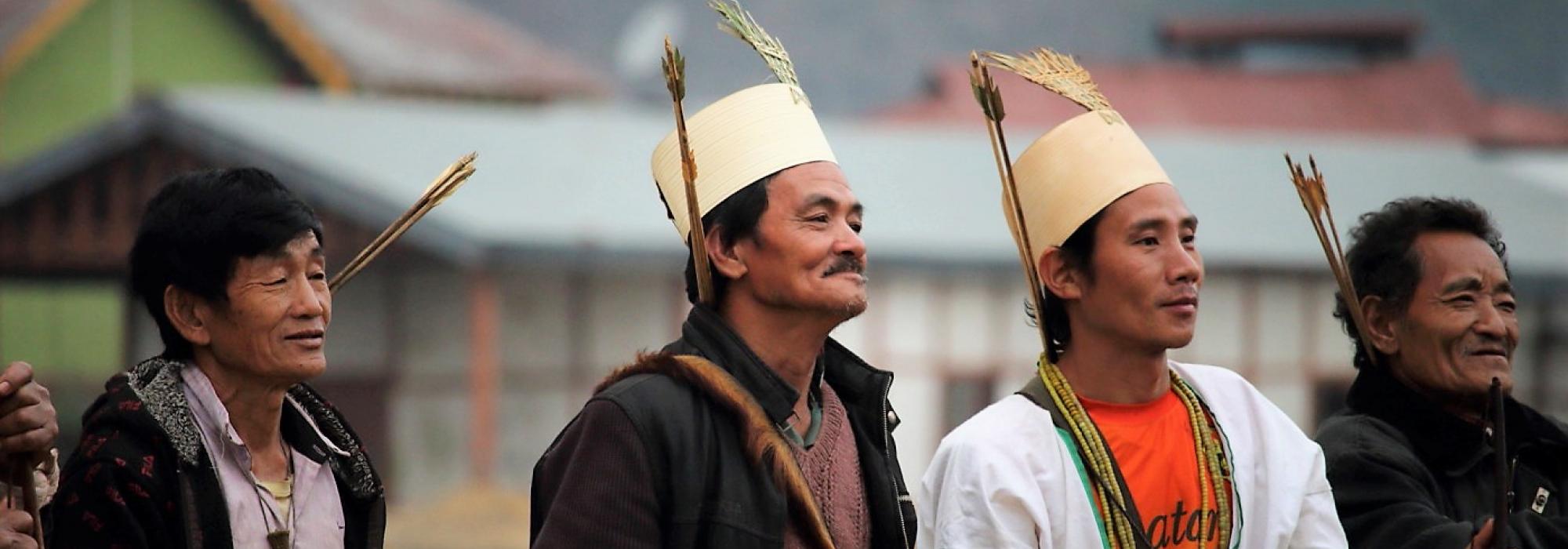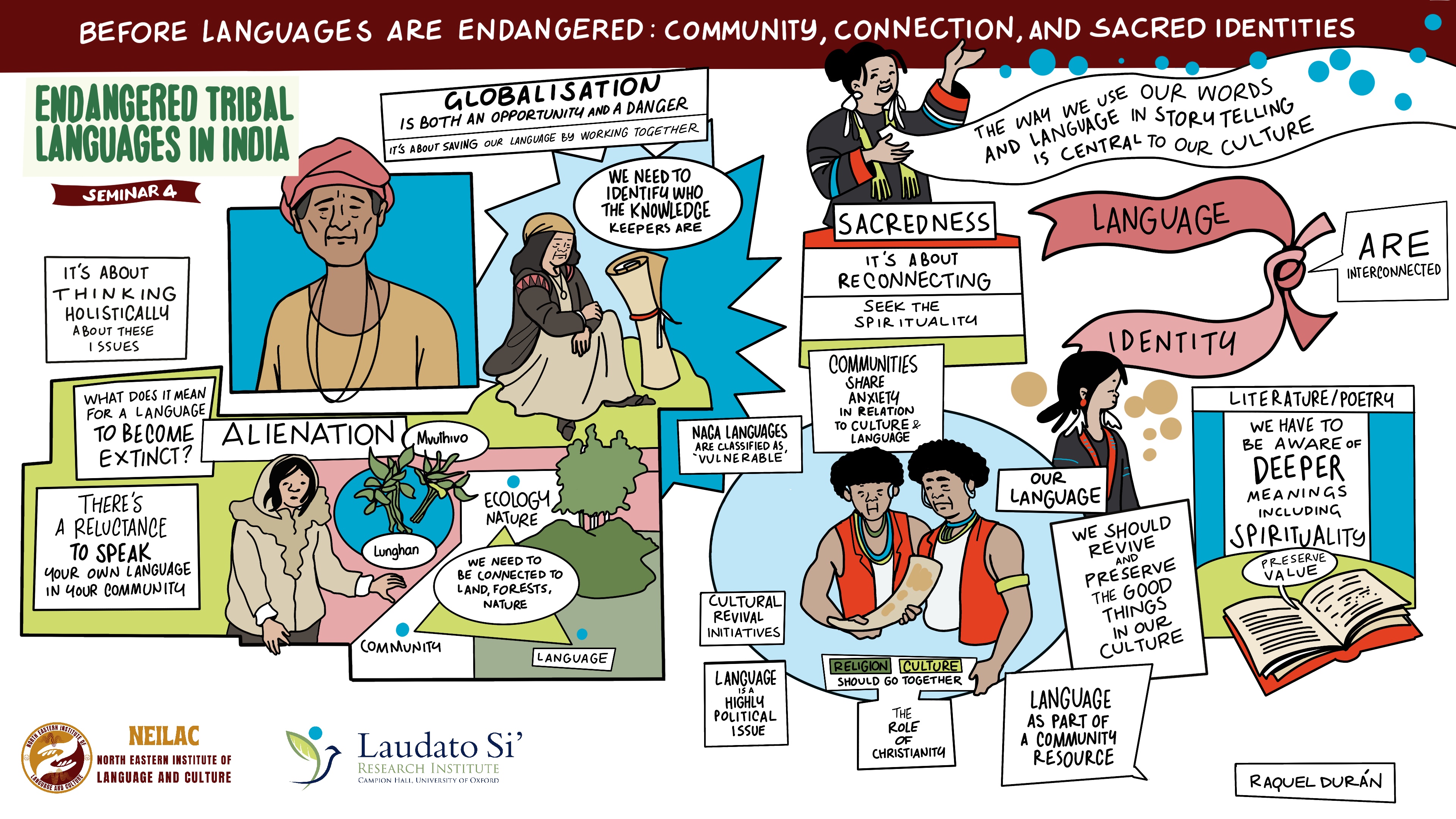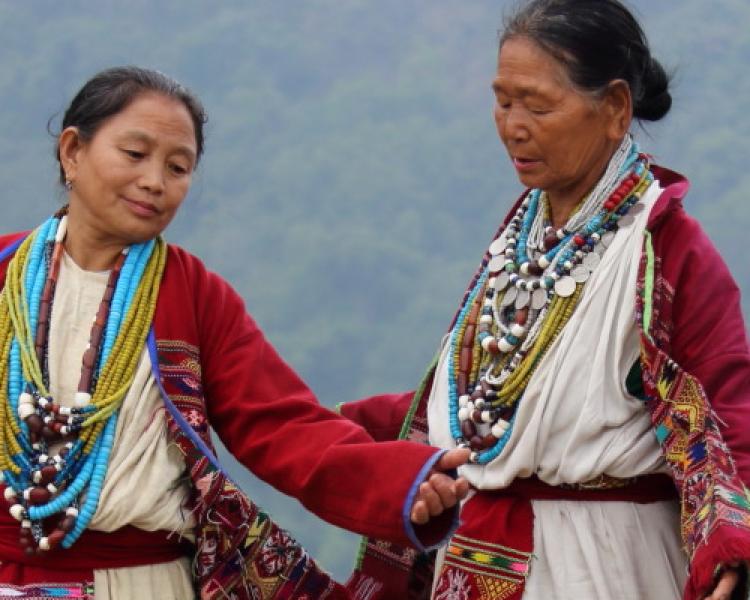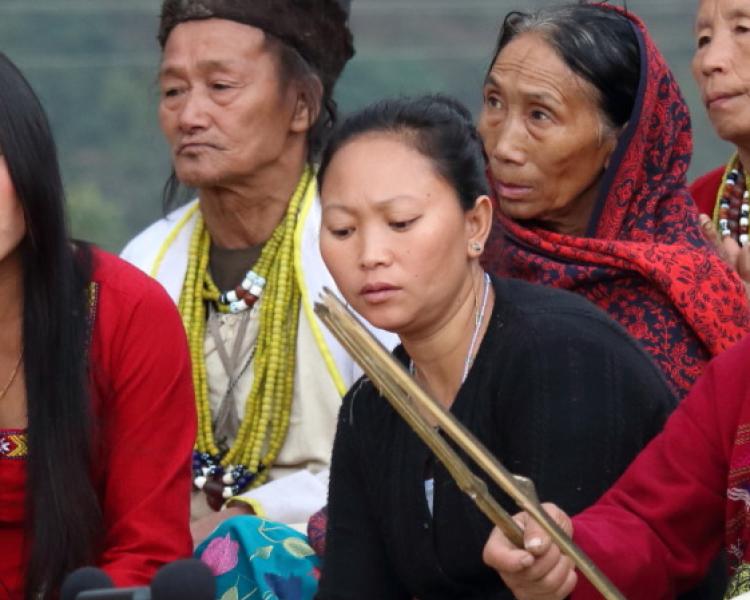
Transdisciplinary Dialogues Series: Endangered Tribal Languages in India (4)
Key Details
Seminar 4: Before languages are endangered: Community, connection, and sacred identities
Our fourth seminar, held in November 2022, was entitled Before Languages are Endangered: Community, Connection, and Sacred Identities.
It explored how, as communities lose their native language, they also lose cultural traditions that are tied to that language, such as songs, myths, poetry, remedies, and ecological and geological knowledge. Furthermore, the social structure of one’s community is often reflected through speech and language behaviour. This seminar addressed the correlation between minority languages and dialects, and the deep structure of human identity and community cohesion.
Speakers:
- Dr Dolly Kikon (Melbourne University),
- Iliyana Angelova (University of Bremen)
- Professor Justin Jones (University of Oxford), Chair
Visual Map of the Dialogue:

Session Summary:
Dr Dolly Kikon initiated the fourth seminar of the series by posing the question, “What does it mean to be extinct?” She reflected on her native Lotha Naga language and how, in many families, even though parents are fluent speakers, children refuse to speak their mother tongue and opt instead for English. The problem, she claimed, is our failure to recognize the external forces responsible for language loss, instead blaming family and community for the refusal to speak one’s own language. She pondered over how to make sense of this type of alienation, where young students or professionals seeking to explore the world reject their ancestral languages as useless. We must reflect not only on language loss, but also on the practices that lead to language endangerment.
Dolly continued to reflect on the theme of endangerment and loss, using the example of an edible plant called Lunghan/Nunga in Lotha, which was abundant during her childhood. Her mother would buy it from the market and prepare it in various ways. However, when she recently went to the market and asked the women selling this plant in Nagamese (a link language among different Naga tribes and a market language along the foothills between Assam and Nagaland) for its name, she was told that it is called napa patta, which translates to “a leaf that cannot be found”. This term shocked her because the plant she ate so frequently a few years ago is now rare. She discovered multiple names for the same plant through her interactions with missionaries who translated the English Bible into Lotha. To her this implied that impoverishment of her environment is reflected in impoverishment of the language. She emphasized the importance of reflecting together on this phenomenon of loss as the younger Naga generation negotiates questions of ecology, language, and community.
She discussed three additional plants to demonstrate how people’s connection with their environment is shaped by language, and how plant names reflect their experiences with the plants. Through stories shared by the elders about the connections between natural resources, forests, communities, and language, a new world of understanding opens up regarding sovereignty, ecology, community, and the future.
Dolly emphasized the importance of recognizing knowledge keepers among the indigenous people when discussing sacred identities and endangered knowledge systems. Understanding their language and the richness of their knowledge is critical for shared learning. Dolly herself continues to learn from the knowledge keepers in her community, particularly with regards to the ecology and food. In 2019, she produced a documentary called Seasons of Life which explored the practices of foraging and fermenting bamboo shoot during a ceasefire in her conflict-ridden state. This was inspired by her work with human rights under the Armed Forces Special Powers Act (AFSPA) and the intersection between sovereignty, food, and plants. As a writer and thinker, Dolly constantly translates in her head between different languages, and the importance of the Lotha and Nagamese languages are crucial to her work. She concluded her talk by screening a short clip from her documentary film.
The second presenter, Iliyana Angelova, discussed the politics of identity, language, and cultural reproduction among the Sümi Naga in Nagaland. She began by providing an overview of the UNESCO Atlas of the World’s Languages in Danger 2010, which classifies Naga languages as vulnerable. UNESCO defines “vulnerable” as a situation in which most children speak the language, but only in certain social domains, and typically at home. More than half of the endangered languages in India are Tibeto-Burman languages in Northeast India.
The decline of these languages is due to various factors such as lack of transmission at home or schools, as well as limited state support. The political power structure of languages and scripts also plays a role, with unscripted and unofficial languages being at a disadvantage. In Nagaland, linguistic diversity is such that no single indigenous language is accepted as the official language, with English being the official language instead. This decision reflects not only a desire to claim a cultural identity independent of Assam/ India/ Hinduism but also intra-state identity politics.
While some Naga languages are taught in schools, this mostly occurs in rural areas. Nagamese, a pidgin derived mostly from Assamese, is widely used in urban contexts, but some people see it as representing an unwelcome degree of influence from mainland India. English is often part of the Christian Naga identity.
The Sümi Nagas, also known as Sema in colonial writing, predominantly live today in the Zuneboto and Dimapur districts of Nagaland. Since the 1970s they have been experiencing cultural and linguistic anxieties, including a sense of loss of cultural identity and a desire to revive, revitalize, and rediscover it, which has become more pronounced in recent years. The Second Great Evangelical Revival provided them with an opportunity to reinvigorate their missionary zeal and re-evaluate the conversion model and past mistakes.
During the early 20th century and especially in the 1950s, conversion was seen as a rejection of one’s traditional culture and a symbolic act of adopting a new Christian identity that required burning traditional insignia. The relationship between Christianity and traditional identity was complex, as some believed that traditional designs on treasures and dresses were copied from the devil and should be discarded. This led to the loss of many cultural and traditional items.
However, some village elders now believe that religion and culture should go hand in hand, and that traditional values should be preserved for future generations. They encourage people to wear traditional attire in church, although some garments are only worn during festivals. They acknowledge that many traditional values were almost lost but are now being recollected and revived, without neglecting their church. As one elder said, “we have understood that religion and culture should go together. We should not leave our old systems behind because of Christianity. The bad things we should not touch but for the good we should preserve it for the generations… But we don’t neglect our church and we encourage people to wear traditional attires in church but some attires, we wear only during festivals”.
Iliyana stated that she was interested in the “good and bad things” that they were referring to. There were three important ‘good things’ that the Sümi community valued: first, the traditional crafts such as weaving, jewellery making and wood carvings; second, the meaningful celebration of major festivals like Tuluni in a traditional way; and third, the preservation of the Sümi language. She also highlighted the concerns of some community elders regarding the loss of Sümi language usage among the younger generations, who often mix it with Nagamese or other languages they prefer. While elders worry about foreign influences and cultural mixing, younger generations embrace contemporary Naga culture. Despite this, the Sümi language is still widely used in social interactions and church services, and efforts have been made to promote it through the Sümi Literature Board and the Sütsa Academy, Zuneboto. Iliyana reflected on the relationship between language and identity, and emphasized the importance of language in connecting to community resources. While some elders fear the decline of the mother tongue, the reality is not necessarily as dire but there are broader anxieties about traditional culture and language mixing.




